|
Monday, Janury 26, 2009
Progress Notes
Last week I had the opportunity to visit Gene and Helen (Martin) Edwards of Ulman, Missouri (photo 01).
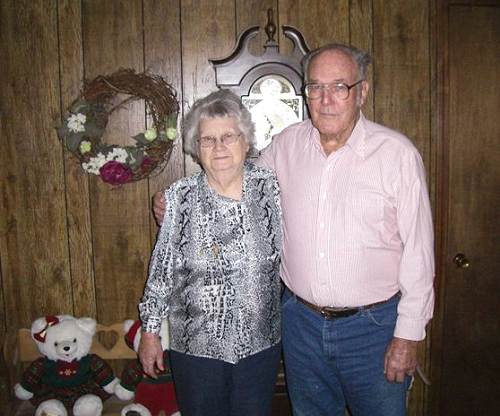
01 Gene and Helen Edwards
Gene is a grandson of George Edwards, well known early settler of Miller County whose home farm was located off Highway 52 between Tuscumbia and St. Elizabeth on the King’s Bluff area of the Osage River (photo 02).
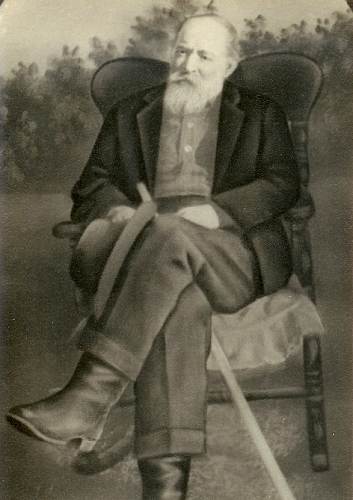
02 George Washington Edwards
Descendents of George are numerous in the area since he had a large family having had two different wives. I previously discussed George about a year ago on this edition of Progress Notes.
I have known Gene all my life and respected greatly his sympathetic and caring nature as a Christian Church denomination minister who always has made a special effort to reach out to our elderly and/or disabled residents of the various nursing facilities in the area. His preaching and teaching is very much the same as that of Charles Sooter, who was a Christian Church minister of the late 1800’s and early 1900’s (photo 03).
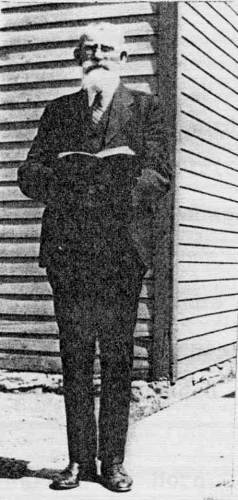
03 Charles Marriot Sooter
Charles started thirteen churches in Miller County and is known as one of the most respected ministers ever to have lived here. I wrote about Charles Sooter last year in this edition of Progress Notes.
I have thought that Gene was very similar to Charles Sooter not only in his preaching style but also in the prodigious number of funerals and baptisms he has performed over the years in our county, an indication as to how well he is respected by the many families who choose him to be the one to be with them in times of need or joy. Gene’s attraction to many is that he truly is one of the “Old time preachers” with a preaching style common one hundred years ago but not very prevalent these days. I believe he is one of the few remaining links to our past regarding church history, something he wouldn’t deny and in fact is proud of it! He doesn’t refrain at all in referring to himself as “just an old time hillbilly preacher!”
Gene told me he was first influenced to be interested in the ministry by his mother. In fact, early on when Gene was only twelve or thirteen years old, he would read his Bible while tending a team of horses in the field, something that seems to me would have taken not only reading skill but teamster skills as well. The family church growing up for the Edwards family was the Mount Zion Church south of Tuscumbia on Highway 52 (photo 04).
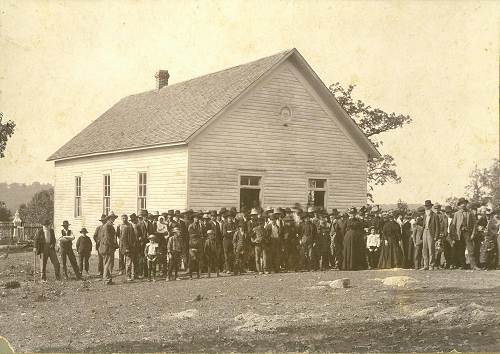
04 First Mount Zion Church - 1901
Click image for larger view
Just across the road from the church is where the Miller County Care and Rehabilitation Center is now located (photo 05).
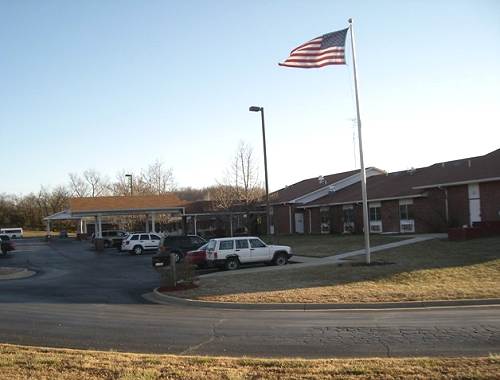
05 Miller County Care and Rehabilitation Center
And it was at this facility years ago when it was known as the Miller County Nursing Home (and before that simply as the “County Home”) where Gene preached his first sermon (photo 06).
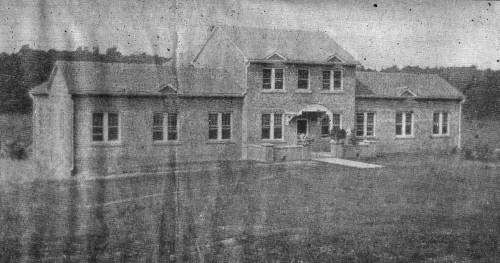
06 Miller County Nursing Home
It wasn’t long after that when Gene substituted often for Mark Sooter (photo 07), son of Charles, in preaching at Mount Zion Church and where later, after Mark retired, that Gene became the next preacher there.
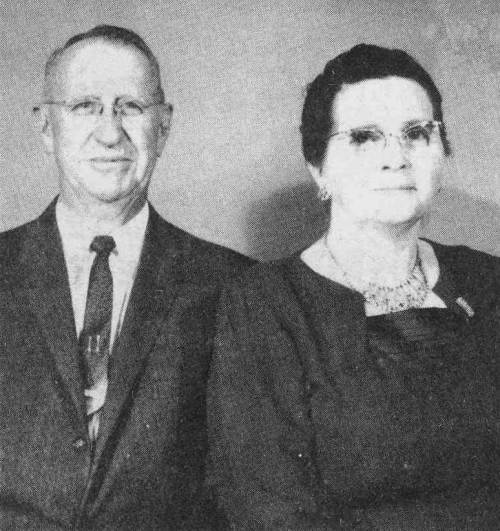
07 Reverend and Mrs. Mark Sooter - Sept. 1974
You can read more about this historical church at this URL on our website:
http://www.millercountymuseum.org/christian.html
You will need to scroll half way down the page to get to the section on Mount Zion Church.
After Mount Zion Gene preached for nearly twenty years at Tuscumbia Christian Church (photo 08) and in recent years has been preaching at Ulman Christian Church (photo 09).
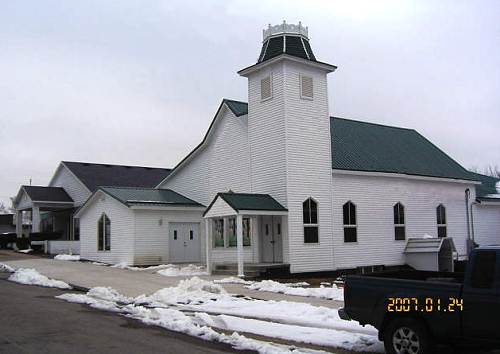
08 Tuscumbia Christian Church
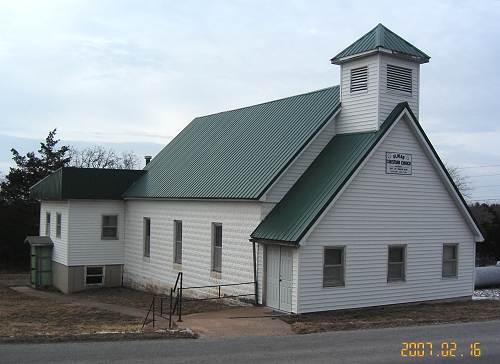
09 Ulman Christian Church
You can read about these two churches also at the URL address listed above.
One of the most remarkable aspects of Gene’s preaching is his amazing recall of scripture. I asked him the other day how he had memorized so much of the Bible. He told me he reads the Old Testament once every winter and reads the New Testament five times every summer. He always reads the King James translation.
But Gene never has made his living from preaching. He always has been a full time farmer primarily raising turkeys and cattle on his farm near Ulman. Because he was born and raised here in the county and has spent his life farming, Gene is one of the preachers of the area who has lived here the longest and probably one of the best known for that reason.
Recently, Gene gave a very interesting interview to Peggy E. Trachi, a niece of his, which was published in the book, Edwards Family Memories, a copy of which I am presenting below:
Otis Gene Edwards
Joe and Letha Edwards’ third child, Otis Gene, was born at their home in Meta, Missouri on May 15, 1927 (photo 10).
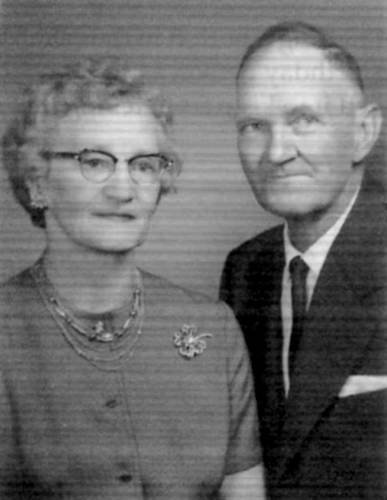
10 Joe and Letha Edwards - 1964
At the time of his birth, his brother Earl was seven years old and his sister Ruth was five. It was later told to Gene by his mother, Letha, that she thought him a beautiful baby with his thick, black curly hair.
Growing up in the Edwards family was never dull. Gene thought his dad, Joe, to be a very funny man who kept everyone in stitches with his funny sayings. When Gene would ask his father why he was doing something, Joe would reply, “Why, just for the fun there are in it!” When visitors would show up, and they would show up often, Joe would greet them with, “Jerk ‘em up and jump down.” Often after a long, hard morning out in the fields, Joe would come to the house for the noon meal and sometimes sit down for a short rest afterwards. When it was time to get up and return to his work, he’d say, “Well, I better git agoin’ ‘cause I’m a settin’ up like concrete.” Joe had a quick wit about him and one day when he and his brother, John (photo 11), were up at the lake he proved it.
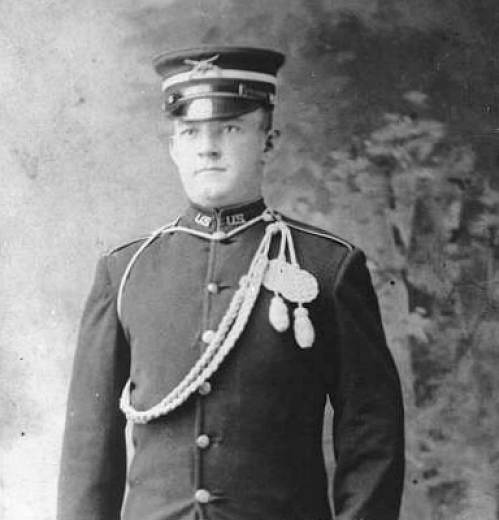
11 John Gill Edwards
A tourist, noticing him dressed in overalls and thinking him to look like a hillbilly, approached and asked in a snickering voice, “What do you all do around here?” Joe, not skipping a beat, replied, “In the wintertime we skin frogs, and in the summertime we skin tourists.” Hoots of laughter followed since Joe and John knew that the tourist from the city probably didn’t know that frogs are scarce in the wintertime and might actually think that hillbillys might just skin tourists. Gene often observed his dad horsing around with his Uncle John like the time John reached over, grabbed Joe’s hat, threw it into the air, aimed his gun, shot and missed. Joe, in return, reached over, grabbed John’s hat and repeated John’s actions. Instead of missing, though, he blew the whole top out of his brother’s hat. Everyone got a chuckle out of it, and Gene walked away mighty impressed with his dad’s shooting skills. In addition to his father’s keen sense of humor, Gene remembers his father as a good man and a good dad. His dad taught him to hunt and fish, and through the years Gene came to view him as a good buddy too. Although there were genuine moments of fun around the Edwards farm, the prevailing motto his father instilled in his children was …”Work, work, work.”
Gene’s mother, Letha, was a loving mother, and her gentle, happy spirit was a good example to her children throughout their lives. No one ever knew if she even had a pain, because she was not a complainer. If a tough time came, she got through it with as much laughter as she could muster. When Gene thinks of his mother, he pictures her standing in the kitchen with a large mixing bowl under her arm. Letha was an excellent baker and cook. Their neighbor, Mrs. Luetkemeyer, shared her “Dutch” yeast with Letha which she used to bake the tastiest treats. Fresh homemade bread after school was an all time favorite of all the Edwards children. Gene loved to cut off the top crust and smear it with fresh butter and molasses. Their other neighbors, the Huhmans, had a large apple orchard, and they shared the harvest with their friends and neighbors. When the apples were ready to be gathered, Claire Huhman would invite Letha over to help harvest them. The end result was a pantry full of delicious pies, apple butter, and crisp cider. Large quantities of apples were buried in the garden alongside the turnips for use during the winter months. The apples and turnips rested in deep holes which had been dug and then lined with straw. Gene also vividly remembers how delicious his mother’s angel food cake and divinity tasted. When they were not working to produce their own food, they were enjoying the fruits of their labor.
Each evening, Gene’s family would sit down together to eat. In the summer, this meant eating at a table out on the screened back porch where it was cool, breezy and relaxing. In the winter, they ate together in the kitchen warmed by the heat of the oven, and their Sunday meals were always enjoyed in the dining room. Fried chicken was one of Gene’s all time favorite Sunday meals. In order to guarantee that he would get his favorite pieces of chicken, Gene would sneak into the dining room ahead of time and take a bite out of each piece he wanted and tuck them up under the edges of his plate. Many evenings after supper, Gene enjoyed listening to the Jack Armstrong program on the radio while his father read the paper. After awhile his dad would ask, “Time to bring in the wood?” This was his reminder that the cows needed milking and the wood needed to be “pulled in.”
In the earliest years of his life, Gene’s family lived in Meta where he recalls walking to the store in VanCleef to buy and carry home groceries for his mother. Although they produced the majority of their own food, food staples such as flour, sugar and salt needed to be purchased. As he recalls, a buddy was usually with him when he was sent, and often they would play with the snakes in the creek on their journey. One of his most vivid memories while living in Meta was the night he made his way to the outhouse and there was an enormous moon shining through the old walnut tree. That same tree still stands while everything else has disappeared and is well over 100 years old.
When Gene was five years old his family moved from the Meta farm to the Edwards farm located on the Osage River. His grandmother, Tennessee Barnhart, was not well, was now widowed and needed assistance. He remembers her poking him with the end of a broom handle from time to time. She kept graham crackers under her bed, and he would sneak under it while she was napping to snitch a few. Of Course, she wasn’t too pleased by this. Thus, the end of the broom handle became her weapon of defense. “You little devil!”
Although Gene was less than two years old when his grandfather, George W. Edwards died, he grew up enjoying some of the fruits of his grandfather’s labors and heard a good story or two about him from time to time. His grandpa George had planted an apple orchard and a variety of nut trees on six acres in the “upper bottom” located not far from the big barn. Just across from the orchard and on the same piece of ground, he had also planted a large flower garden that included peonies and roses. Grandpa George would hook up his workhorse, Old John, and plow the earth around his orchard and the flower beds. He was a lover of flowers and maintained a prolific garden for his own pleasure and the pleasure of others. One of the stories which Gene recalls about his grandfather revolved around the loaning of his workhorse to his sons, Joe and John. Old John was a horse that passed a lot of gas. Joe and John thought it would be funny to light a fire behind him each time he let one loose. Each time they did, he would jump forward with a jerk, By the time he was returned to Grandpa George, he had the habit of automatically surging forward each time he passed gas. Grandpa George was fairly perturbed and swore to never loan them anything else ever again.
Living on a farm meant having constant chores, but there were also times for play. Gene’s main responsibilities were to split firewood and “pull it in,” milk the cows, hoe the corn, plow the fields and cut the sprouts. In addition to working on the family farm, he worked for others to earn money to pay for his overalls and other clothing. When Gene was 12 or 13 years old Bill Wilson paid him 50 cents a day to gather corn. Once when he was hoeing corn for Bill, Elmer Gentry told Bill that Gene deserved 75 cents a day just like all the other workers. From then on he made the same wage as the adult workers. When the work of the day was complete, there were many entertaining things to do. One of Gene’s favorite activities was to run with a metal hoop which had come off of the hub of a wagon wheel and a stick attached to a small board to direct it. He would run it all around the yard, up and down the road and just about anywhere else he wanted to take. Playmates were never scarce, and on summer evenings they would all get together and play Dare Base, Hide and Seek, or clobber each other in a spirited corncob fight. Each and every Sunday of the hot summer, they would all swim in the river to cool off.
Gene’s cousin and neighbor, Jack Edwards, was his best playmate. They fished on the river with cane poles, hunted in the woods with the Edwards’ dog, Ol’ Frank, who could run rabbits better than any dog around, swam together in the river and, in general, could find multiple ways to get into mischief. On warm summer days, they would shed their clothes leaving them on the rocks at King’s Bluff, hike several miles upstream, and then ride logs back down to the bluff where they would retrieve their clothes. They also liked to bathe in an oversized black iron kettle that sat near the horse well in the hollow located between the two farms. It was used to hold fresh spring water for the livestock. Once, while they were skinny dipping in the oversized kettle, their sisters, Ruth and Eileen sneaked up, grabbed their clothes and ran off with them. On really hot summer days, they liked to snitch a watermelon out of Uncle John’s patch, break it open and enjoy it under the shade of a big tree. One summer Gene had very gradually and methodically stolen 15 or 20 melons and hidden them in pockets he had made in one of his Uncle John’s haystacks. One day, as the school bus delivered him home from school, he watched in great dismay as the haystack was going up in smoke. Uncle John had set it afire not realizing it was loaded with watermelons. In the winter when there was snow and ice on the river, Gene and Jack had lots of fun skimming on their feet across to the other side. Often times the ice on the river would be cracking as they slid over it which just added even more excitement and entertainment to their fun. Sledding was another favorite of Gene’s wintertime activities, and there were many hills and knolls upon which to sled. He recalls a particularly snowy day when his mother pulled him on his sled all the way to John Renfrow’s house which was some distance from the Edwards’ farm. When it was time to return home after their visit, the snow had melted making it necessary for him to walk and carry his sled which really upset him.
Gene admits that he hated school and could have completely done without it. In his own words, he “went in one door and out the other.” “I was the last one in and the first one out.” This however, didn’t deter him from having some fun with it. He recalls the day that he, Jack and Archie Edwards used the rope from the well bucket and wrapped it around the outhouse while their teacher, Opal Duncan, was inside. Another time he broke off a blackberry briar and from the back side of the outhouse reached up and swished it against her bottom while she was sitting on the toilet. After grade school, he went on to attend one year of high school where T.C. Wright was his favorite teacher. He remembers a day when T.C. took him out to a barn on his small farm to show him how he trapped rats. There, in the barn, was a barrel of feed with a ramp leading up to the edge and inside were 25 or 30 rats. The rats had scurried up the ramp, fallen into the barrel but were unable to escape. Two by fours were then used to kill them. Letting all the air out of the teachers’ car tires, setting off firecrackers and throwing them at the school were a few other ways he found to keep things interesting. Of course, the day he burned his hand may have slowed him down some.
At the age of 17, Gene joined the Army transportation Corps and was in maritime service in the Pacific Ocean (photo 12).

12 Gene Edwards
He spent 18 months as an engineer on a ship repairing military aircraft. One day while on a short leave in the Philippines, he hitched a ride on a truck. When he got to his destination, he jumped off the truck and as he did so, a ring he had made from a steel nut caught on something and tore off his finger. Nowadays when asked how he lost his finger, he has a very interesting answer. Just ask him.
Not long after returning to Tuscumbia, he met Helen Martin at a community event, and they were married just ten weeks later. Their nuptials took place on May 20, 1945 at the courthouse in Camdenton, Missouri, and they spent some time that day at Ha Ha Tonka before returning to their home. Their first home together was in Lee’s Summit where Gene had been working in a pork packing house. A year later they welcomed Samuel Gene into their family. This same year, 1950, they bought the farm near Ulman where they continue to live. Three years later a second son, Fred DeWayne came along to complete their family. When asked what he most remembers about his sons when they were very young, he chuckles over how Sam would sit for hours on the tractor making noises as though he was actually driving it, and how Fred was “the whittler,” always sitting on the back porch whittling.
Gene had grown up attending Mt. Zion Christian Church, but it wasn’t until after he had established his own family and was 30 years of age that he surrendered his life to Jesus Christ. At this time, he was baptized in Dog Creek (photo 13) by the well loved and respected Reverend Mark Sooter.

13 Dog Creek
From this time on Gene dedicated himself to growing in his faith and endeavoring to please his Lord and Savior through service to others. He was a Sunday School teacher at Mt. Zion Christian Church for many years and later felt called to take the step of becoming an ordained minster. Over the years he has preached from the pulpits of several churches in and around the Tuscumbia area and has ministered faithfully, especially to the elderly, through his messages, music and words of encouragement. Most recently, he preaches at the Ulman Christian Church and is often called upon to perform baptisms, weddings, and preach funerals. His best words of advice to his sons, four grandchildren, Jill, Simon, Cody and Crystal and his six great grandchildren are to “seek to be a Christian in every work and deed.”
Gene is very fond of interacting with older folks and enjoys telling stories about his funny and fond memories of them. There was the time when Fred Hendricks was digging post holes with an old, worn out posthole digger. He was having a hard time when Gene came along and offered to help him. After the holes were dug, Fred asked, “How much do me owe you?” When Gene replied that he owed him nothing, Fred countered , “I’ll have you dig me two more!” Another time when he stopped by to visit, he was greeted by Fred sitting up on his tractor completely stark naked and spitting tobacco on himself. Andy Neal was another elderly friend that once gave him a dollar and said, “Pray for me.” He remembers when Oscar Pendleton drank 15 bottles of pop in one day, and also how Oscar loved to play with tops. Gene once bought several plastic tops and when he next saw Oscar, he challenged him to see whose top would spin the longest. The new plastic one won out over Oscar’s old wooden one. Oscar’s disappointment didn’t last long though once he learned that Gene had bought the handful of new tops for him. Although Gene often enjoys telling stories from the past, the stories of these elderly friends seem to always bring a special smile to his face.
On his farm just outside Ulman, Missouri, Gene has spent many years raising cattle and turkeys. He also farms catfish in the large pond that is located behind the log home in which he and Helen have lived for so many years. When visitors come to call he likes to invite them to walk out to the end of the dock over his pond, throw feed out across the railing and watch hundreds of catfish swarm to feed. Over the years Gene and Helen have enjoyed their farm, annual gardens and all the wildlife that continuously roam across their acres. Gene still produces his own molasses just as he learned to do growing up, and has planted and coaxed into maturity a great quantity of walnut trees. The walnuts he used for the plantings were from the trees that grew on his childhood farm.
In his opinion, the best thing that has happened in his lifetime is that the standard of living has increased. The worst thing that has happened in his lifetime is the falling away from God. Probably the one thing he personally misses most about the old days is his own physical flexibility. However, although his flexibility may be hampered, he is in good health and continues to actively minister to others through his music, words and deeds.
Information gathered from Gene Edwards in July 2007
Compiled and written by Peggy E. Trachi
Thanks Peggy.
Gene and I can talk back and forth about a lot of common interests and experiences. One of the reasons I visited him the other day was to walk over the farm which he has owned since the 1950’s. This farm early on was owned by a great great uncle of mine, Simeon Bear (photo 14) so I found it interesting to locate the site where Simeon had his home on the farm.
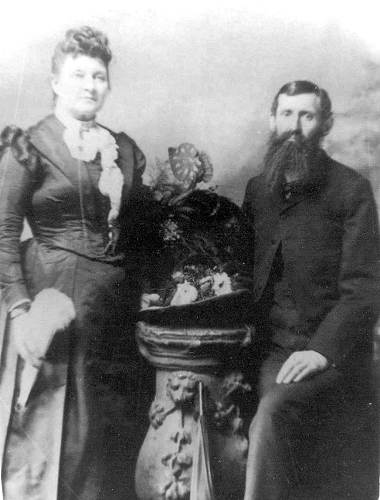
14 Simeon and Louisa Bear
Also, the church where Gene preaches now, Ulman Christian Church, was endowed by Simeon, whose name is on the sign above the front door of the church (photo 15).
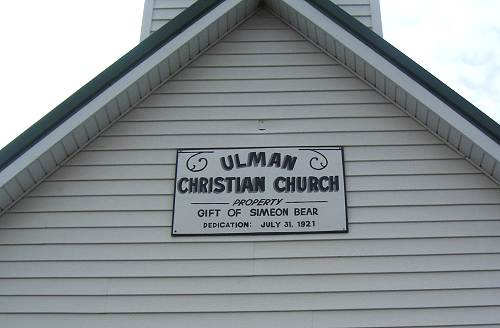
15 Ulman Christian Church Nameplate
Myrna McGowin has written a short history of the church:
ULMAN CHRISTIAN CHURCH
By Myrna McGowin
Simeon Bear, a pioneer resident of Ulman, willed one acre of ground and one thousand six hundred dollars to be used in the building of a Christian Church building in Ulman. He appointed A.C. Jackson, James C. Thompson and George Bear as administrators of this building fund and land to see that his will be carried out.
The church building was erected in 1921. The contractors moved their machinery to the site of the building and made the blocks of which the building was made.
Some of the charter members were: Mrs. A.P. Nixdorf, Mrs. R. Crismon, Mrs. Grace Hix, Mr. and Mrs. Rig Patterson. After the building was completed James C. Thompson appointed Rufus Crismon, A.P. Nixdorf and C.B. Bass as trustees.
A Brother Brown held the first revival meeting and dedication during which time a great number members were added. Brother W.H. Scott became the first pastor of the church and Mrs. C.B. Bass was the first Sunday school superintendent. Mrs. Lora Abbett was the first pianist.
The building still stands as it was erected in 1921 with the addition of a belfry in 1930. A new pine floor has been placed over the original concrete floor and the interior redecorated.
In 1970 an addition was placed on the back of the original building which houses classrooms and a basement.
Thanks Myna,
Here is a copy of the original church charter (photo 16):
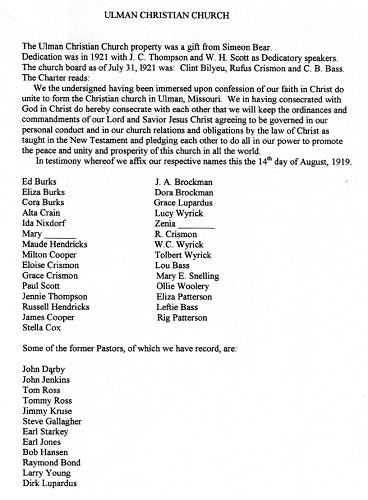
16 Charter and Charter Members
Click image to view document in PDF format
Before the day ended, Gene and I went over to Brays Advent Christian Church (photo 17) where the Union Cemetery is located (photo 18).
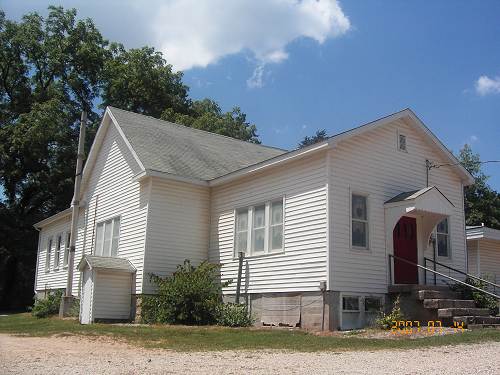
17 Brays Advent Christian Church

18 Union Cemetery
This church is one of the more interesting ones in the county and is discussed in detail at this URL on our web site:
http://www.millercountymuseum.org/communities/brays.html
Here is an old photo of the inside of the church (photo 19):
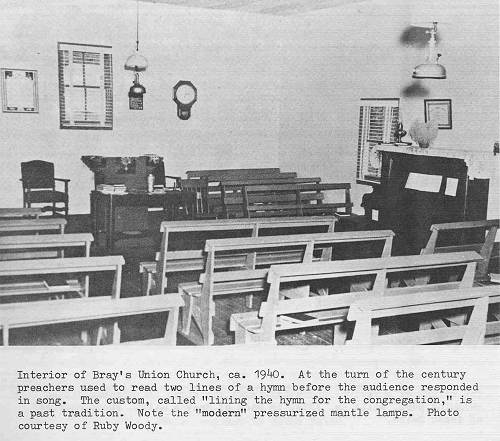
19 Brays Union Church
Click image for larger view
The Union Cemetery is where most of the early Sooter family members were buried including Charles Sooter as well as his father, Harvey. Here are photos of their tombstones (photos 20 and 21):
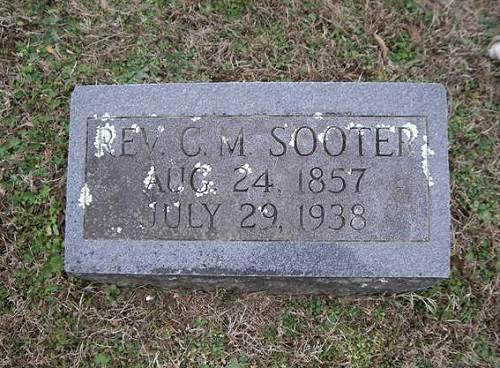
20 Charles M. Sooter
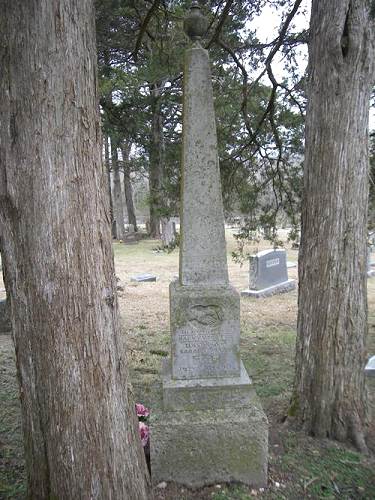
21 Harvey V. Sooter
Gene has a lot of respect for the Sooter family of preachers, especially Charles, and both of us were very interested in reviewing what we remembered about them.
On our return I asked Gene to tell me about his log house (photo 22).
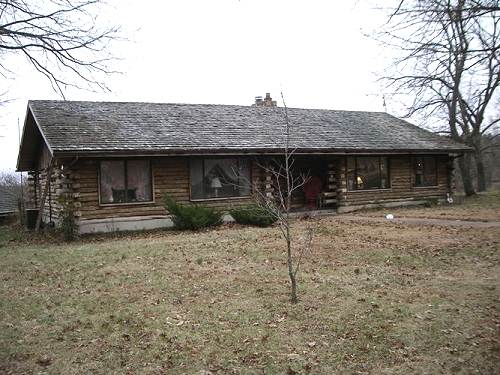
22 Gene's Log Home
Gene said that in about 1980 he and Helen decided to move out of the old Simeon Bear home into a new one that they were going to build of logs. Gene bought a sawmill from Gaylord McDaniel which he set up on his farm. He and his son, Fred, worked for the better part of a year sawing timber off the farm and placing the logs. Gene and Helen worked out the floor plan and she took charge of the interior design. Gene put in a large Skaggs wood furnace for which he still at eighty one years of age, cuts the wood. At the moment, Gene pretty much is retired from farming but remains active in his preaching and nursing home ministries. He also has a couple of Martin guitars which he enjoys playing while he sings the old gospel songs.
After dinner (lunch) of delicious homemade chili made by Helen using home grown and butchered beef, I thanked Gene for his time and left for home.
In the above story Gene mentioned to me that he first started preaching at the Miller County Nursing Home back in the 1960’s. I thought I might finish up this week’s Progress Notes with some of the history of our Miller Health and Rehabilitation Center. Peggy Hake has written an article about the first residence the county had which was used for the ill and aged but also for the poor. And actually, to begin with, the facility indeed was called the Miller County Poor Farm. So let’s read what Peggy has to say:
The Miller County “Poor Farm”
Peggy Hake
Windows From the Past
Miller County Autogram (date not given)
From Goodspeed’s “History of Cole, Moniteau, Morgan, Benton, Miller, Maries and Osage Counties,” written in 1889, page 543:
A farm of 215 acres was bought (by the county) in 1884 about a mile below Tuscumbia, on the right bank (south) of the river and W. A. (Wesley) Hackney became its first superintendent. It has several frame buildings and a few inmates under the care of J.E. (James) Walker.”
With those few words recorded over 100 years ago in Goodspeed’s History, the history of the county’s “poor farm” (also referred to as the “poor house”) had its unpretentious beginning. From 1884 through February 1888, Wesley A. Hackney was the overseer/superintendent of the poor farm which took in indigent people, who were called paupers in those days.
In November 1886, Wesley Hackney presented his bill to the county for a nine month period during 1886. The following is the contents of the court record:
Support for James Hesling, 9 months @ $50 per year, $45; Support for William Shackleford, 8 months a@ $100 per year, $66.66; Support for B. Smitty, 9 months @ $100 per year $75; Support for Elizabeth Martin, 6 months @ $60 per year $30; Support for Caleb Luttrell, 6 months @ $60 per year $15; Support for Charles Ellis, 3 months @ $60 per year $15; Support for Mathias Themline, 2 months @ $60 per year $10; Support for Ellen Burns, 2 months @ $60 per year $10; Repairs on house at poor farm $8; Total amount of bill $274.66. Credit county by amount heretofore paid by county $190; Credit county by rent of Poor Farm $200; Balance due County by Superintendent $115.33.
From the above bill presented to the county court by W.A. Hackney, it appears that he owed them money for keeping all these paupers during the nine month period. Evidently it was not a profitable business!
However, in February 1887, the county court made an agreement with W.A. Hackney to continue being the overseer of the poor farm. The contract in part stated:
“The court for and in consideration of services hereinafter mentioned grants, devised and lets to W.A. Hackney the following described premised in said county (Miller) and state (Missouri) for the period of one year beginning on the first day of February, 1887 to wit: “The County Poor Farm of said county situated on the Osage River at the mouth of Dog Creek…”. The said Hackney agrees to pay as the annual rents of said farm the sum of $200 and to keep up all fences and cultivate said farm in a husbandman like manner…The said Hackney agrees further that he will keep, feed, closthe, and maintain all county paupers required by the court to be kept on said farm at the following rates viz:
For all paupers as may remain on farm more than three months during year and for all paupers as heretofore classed as “Class A” at the sum of $25 per quarter…it is understood by all parties that said sums shall not be in lieu of medical treatment or funeral expenses of any pauper, which expenses shall in all cases be paid by said county if necessary and reasonable…not to exceed $10…said Hackney shall be entitled to the labor of paupers kept by him who are able to do manual labor and for that purposes authorized to use necessary coercion and discipline for the preservation of the health and cleanliness of such paupers.”
The second overseer as superintendent of the Miller County Poor Farm was James E. Walker, who took over the duties in 1888 from Wesley A. Hackney. He remained the overseer for a few years.
The farm then was sold to the Wyrick family. James Alvin Wyrick and his wife, Sarah J. (Vannata), reared several children on the farm including
1. Oliver Churchill Wyrick;
2. Grace Wyrick (Mrs. Claude Martin);
3.Vivera Ocra Wyrick (Mrs. Ross Adcock);
4. Calvin T. Wyrick;
5. Homer Wyrick;
6. Ray Wyrick;
7. Clay Wyrick;
8. Clarence Wyrick.
Calvin Wyrick and his family lived on the farm until about 1977 when it was sold to Mr. and Mrs. Keith G. Ekstrom, who are the present owners. The Ekstroms have begun renovating the old two story house, which is rich in history. I was privileged to visit with them recently and be shown the unique construction of the house complete with a winding stair case to the upstairs rooms, original windows, facings and ornate trim.
On the property is an old cemetery which has been inventoried as the “Birdsong Cemetery.” It is near the homestead and has some very old grave sites in its boundaries. The oldest known grave is for Benjamin F. Birdsong (1822-1851), a son of Josiah and Nancy (Huddleston) Birdsong. In the cemetery can be found other members of the Birdsong family. Other names are Richardson, Abrams, Lurton and Dayton.
Without seeing an abstract to the land, I have to presume that the Birdsong family were early residents of the property since the old cemetery is located so near the house that later served as the county’s “poor farm.”
Footnote:
In 1930, the county court levied a 10 cents tax per $100 valuation for a period of one year to secure money to buy property to erect a county home. The same year, the court bought 198 acres about two and half miles southeast of Tuscumbia on Highway 17 and built a two story brick building at the cost of $23,000. It was 92 feet by 32 feet and later had other additions (photo 23).
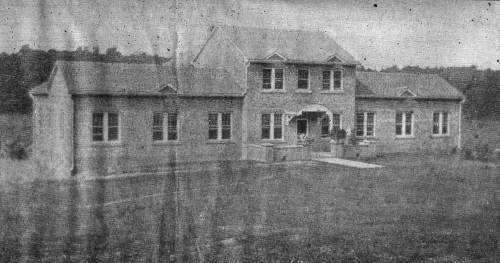
23 Miller County Nursing Home
This county home was used for several decades until a new, more spacious home was constructed nearby. The old two story building was demolished in 1965 and its replacement was named the Miller County Nursing Home, which was funded through a tax levy and was one of the county’s political subdivisions.
In 1997 new construction added the Assisted Living Quarters and then in 2007 a bond was passed to enlarge the facility and add new renovations (see photo 05 above).
Thanks Peggy.
I thought it might be interesting to read what the history of the “Poor Farm” was in surrounding areas so I am copying this article from the Lake Sun (this was from a clipping so I don’t have the date):
Poor Farms in Missouri and Locally
Norine Albers
Lake Sun Publications (date not available)
From the late 1800’s through the 1940’s, counties provided food, clothing and shelter for its homeless and destitute who needed care through county poor farms.
Up until that era, the orphaned, the ill, the mentally challenged, and the vagrant had been placed in asylums and penal institutions. Paupers could be auctioned off to the lowest bidder. The purchased paupers would agree to do certain chores for a specified length of time in exchange for a place to live. Poor farms declined after the Social Security Act of 1935.
Helen Keller’s teacher, Anne Sullivan, lived in an almshouse (poor farm facility) from the age of 10 until she was 21. She recovered much of her vision after several surgeries. She became Helen’s lifelong companion.
To be considered poor was to be dishonorable. Poor farms were maintained on the county level of government. Children could be placed in orphanages or families as wards of the state. Many eastern children were sent to the west via orphan trains There were no facilities for the adults to be housed that could not support themselves.
The idea that the residents could maintain the crops and do daily chores was good. But many of these folks were not able to perform day to day activities to support their stay at the farm. Counties would come to the realization that the poor farms would need to be tax supported.
Laclede County Poor Farm history was well documented in the March, 1988 issue of Briarwood published by the Lebanon Publishing company. In 1871, the first poor farm was established north of Lebanon on the old Case farm.
Encompassing about 360 acres, only about 35 acres were said to be able to be used for farming. An overseer was contracted to maintain and care for the land and the residents. Laclede County would hire 39 overseers during the 64 years that poor farms existed.
The poor farm was moved to Phillipsburg in 1887. Several Missouri county poor farms came under scrutiny by the St. Louis star newspaper in a November 1922 article.
One reporter who visited Laclede County Poor Farm at Phillipsburg had this to say: A tiny log house (pre Civil War) was the first place visited, and the building looked more like a pig pen than a home. Mary, a Negro woman, occupied the hovel.
A broken down iron bed and a pair of filthy comforts were the furnishings. There is no stove.
“How do you keep from freezing.” The writer asked. “I guess the Lord takes care of me but it sure does get ice box cold in here”, she answered.
The article did nothing to change conditions at the poor farm. In fact, the upcoming tax increase for the poor farm was defeated.
Some of the 1879 accounting included: Funeral expense for Sarah M. at $7., four dresses for paupers at $2, taking pauper to poor farm at $1, and making seven pairs of drawers for paupers at $1.15.
One of the largest expenses for poor farms was burial expenses. Most were buried in unmarked graves in potters field areas of local cemeteries. Most had no relatives and no one to be notified of their death.
In 1854, St. Louis opened the first poor house in the state. A farm was opened on what now is the state fairgrounds in 1865.
The Kansas City area of Jackson County bought a 160 acre farm from Henry Washington Younger (Cole Younger’s father) for $1,000 in 1852. The Workhouse (Poor Farm), eventually, became known as Truman Medical Center. It is still in use today as a long term care facility.
The Miller county Poor Farm was built in 1884 near Tuscumbia on Route 52.
Morgan County purchased the Harvey farm in 1877.
Improvements were made to the poor farm, which was located 3 miles east of Versailles. Before 1877, the farm had been rented for use by the poor. In 1913, Morgan County built a brick facility for the county poor. Today it is private residential property.
Camden County’s first poor farm was located in the vicinity of the new bridge on the Lake Ozark side of the river.
The Camden County History of 1889 states that the “farm owned by the county was purchased from the Miller family in 1883. There are two large hewed log houses on the place, set with the ends together, with an entry or hall between them. Since the purchase of this farm, there has been on average about eight paupers maintained here.”
Fern Moreland stated in the Reveille on February 28, 1989, that there was a privately owned poor farm in the Linn Creek area that was supported by county funds.
The next poor farm was the old John Williams farm that was situated near Hugo between Routes V and A.
Mary Hanks operated the last poor farm in Camden County. Located on Possum Hollow Road, it was once the John Cooper farm area.
That's all for this week.
|



